
West Kalimantan is a province of Indonesia. It is one of five Indonesian provinces comprising Kalimantan, the Indonesian part of the island of Borneo. Its capital and largest city is Pontianak. It is bordered by East Kalimantan and Central Kalimantan to the east, the Malaysian state of Sarawak to the north, and the Indian Ocean to the west and the Java Sea to the south. The province has an area of 147,307 km2, and had a population of 4,395,983 at the 2010 Census and 5,414,390 at the 2020 Census; the official estimate as at mid 2022 was 5,541,376. Ethnic groups include the Dayak, Malay, Chinese, Javanese, Bugis, and Madurese. The borders of West Kalimantan roughly trace the mountain ranges surrounding the vast watershed of the Kapuas River, which drains most of the province. The province shares land borders with Central Kalimantan to the southeast, East Kalimantan to the east, and the Malaysian territory of Sarawak to the north.
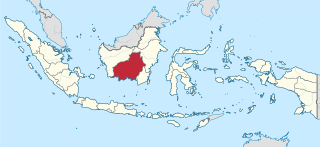
Central Kalimantan is a province of Indonesia. It is one of five provinces in Kalimantan, the Indonesian part of Borneo. It is bordered by West Kalimantan to the west, South Kalimantan and East Kalimantan to the east, Java Sea to the south and is separated narrowly from North Kalimantan and Malaysia by East Kalimantan's Mahakam Ulu Regency. Its provincial capital is Palangka Raya and in 2010 its population was over 2.2 million, while the 2020 Census showed a total of almost 2.67 million; the official estimate as at mid 2022 was 2,741,075.

Elaeocarpus is a genus of nearly five hundred species of flowering plants in the family Elaeocarpaceae native to the Western Indian Ocean, Tropical and Subtropical Asia, and the Pacific. Plants in the genus Elaeocarpus are trees or shrubs with simple leaves, flowers with four or five petals usually, and usually blue fruit.
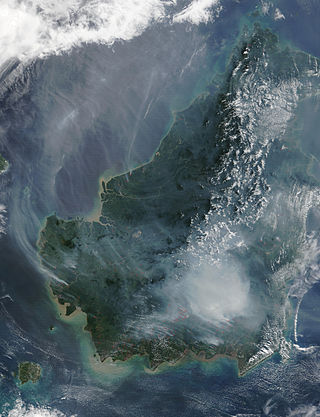
Peat swamp forests are tropical moist forests where waterlogged soil prevents dead leaves and wood from fully decomposing. Over time, this creates a thick layer of acidic peat. Large areas of these forests are being logged at high rates.

The hairy-nosed otter is a semiaquatic mammal endemic to Southeast Asia and one of the rarest and least known otter species. It is threatened by loss of natural resources and poaching.

The Borneo peat swamp forests ecoregion, within the tropical and subtropical moist broadleaf forests biome, are on the island of Borneo, which is divided between Brunei, Indonesia and Malaysia.
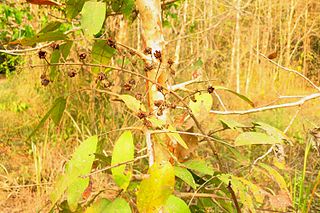
Cratoxylum cochinchinense is a plant now placed in the family Hypericaceae. The specific epithet cochinchinense is from the Latin meaning "of Cochinchina". In Vietnamese C. cochinchinense is usually called thành ngạch nam or lành ngạnh nam, other names include: hoàng ngưu mộc, hoàng ngưu trà and đỏ ngọn.

Aglaia edulis is a tree species of plant in the family Meliaceae. It occurs in Tropical Asia from India to Yunnan and South-Central China. The wood and timber are used for various purposes.
Aglaia leptantha is a species of tree in the family Meliaceae. It is found in Mainland and Island Southeast Asia. People use the plant for food, incense, and for human and bovine medicine. Gibbons also eat parts of the tree.

Hydnocarpus annamensis is a tree in the Achariaceae family. It is found in Thailand, Cambodia, Vietnam, southern Yunnan and southern Guangxi in Zhōngguó/China. It is threatened by habitat loss. The plant produces low-quality wood and its fruits are used in traditional medicine.
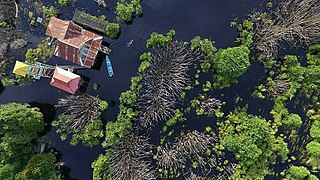
Sabangau National Park is a national park in Central Kalimantan, a province of Indonesia in Kalimantan, the Indonesian part of the island of Borneo established in 2004. Between 1980 and 1995 the site was a massive logging concessions area. After 1995, the park became a site for illegal logging, which resulted in up to 85 percent of the 568,700-hectare total park area being destroyed. By 2012, less than 1 percent of the park's total area has been reforested and at the current rate, it will take several centuries to restore it to its pre-logged state.

Elaeocarpus lanceifolius is a tree species in the family Elaeocarpaceae. It is found across tropical Asia from Thailand to Yunnan to Nepal to Karnataka, India. It is used for its wood, fruit, and nuts.

The Rimba Raya Biodiversity Reserve, nearly the size of Singapore, consists of 64,000 hectares of bio-diverse tropical peat swamp forest that contain as much as 1,000 plant and animal species per hectare and is one of the most highly endangered ecosystems on the planet. The project area and ongoing initiatives focus on environmental conservation, community outreach, and climate control. Rimba Raya is home to one of the few remaining relic populations of wild orangutans and is the largest privately funded orangutan reserve in the world. The area is also one of the world’s largest repositories of carbon. Rimba Raya is the world’s largest REDD+ project -Reduced Emissions from (Avoided) Deforestation and Degradation (REDD). The project developer, InfiniteEARTH, is an industry pioneer, delivering the world’s first REDD methodology in 2009.
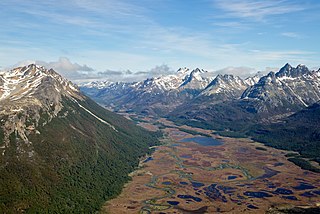
A mire, peatland, or quagmire is a wetland area dominated by living peat-forming plants. Mires arise because of incomplete decomposition of organic matter, usually litter from vegetation, due to water-logging and subsequent anoxia. All types of mires share the common characteristic of being saturated with water, at least seasonally with actively forming peat, while having their own ecosystem. Like coral reefs, mires are unusual landforms that derive mostly from biological rather than physical processes, and can take on characteristic shapes and surface patterning.
Syzygium leucoxylon is a species of plant in the family Myrtaceae, that grows in the tropical peat swamp forest of Sarawak and Kalimantan. The species was described in 1848 by botanist Pieter Willem Korthals from specimens found growing on the mountain Gunung Pamaton, in Borneo.
Mursala Island, also known as Musala Island or Mursalah Island, is an island off the coast of Sumatra. It is administrated by as part of Indonesia's Central Tapanuli Regency in the province of North Sumatra.
Elaeocarpus stipularis is a tree in the Elaeocarpaceae family. It is found from the Aru Islands, eastern Indonesia, to Philippines, and through Mainland Southeast Asia to Odisha, India. It has edible fruit, its wood is used and some medical uses are ascribed to it.
Tetracera sarmentosa is a vine/climber and shrub in the Dilleniaceae family. It is native to parts of Tropical and Temperate Asia, from Peninsular Malaysia to China and Sri Lanka.
Pimelodendron amboinicum is a tree species in the Euphorbiaceae family. It is found from the Solomon Islands in the southwest Pacific, west to Sulawesi in Indonesia. The timber is used locally, though larger-scale illegal logging is apparent.

Onthophagus luridipennis, is a species of dung beetle found in India, Sri Lanka, Thailand, and Indonesia.













